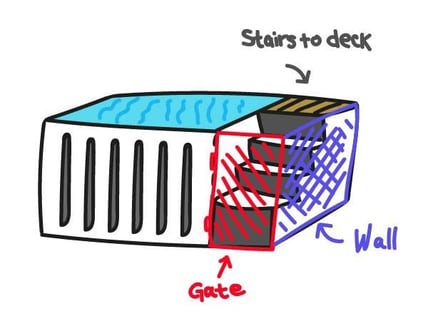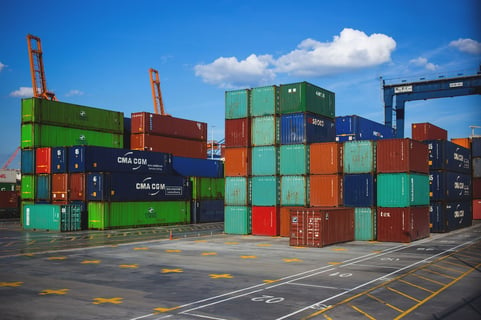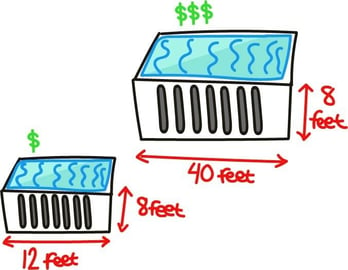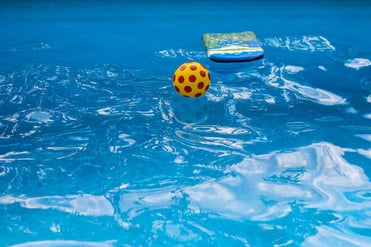They’re cheap, they’re stylish, they look cool...so what’s the catch?
Shipping container pools are awesome, but like anything else in life, they don’t offer a one-size-fits-all type of experience. Some people are drawn to everything a shipping container pool has to offer, while others find it doesn’t meet their needs.
At River Pools®, we like to use our experience and pool industry connections to help educate our readers. This article offers the essential pros and cons of buying and owning a container pool.
Hopefully, by the time you finish reading this, you will have a better idea of whether this pool is right for you and your family.
Shipping Container Pool Pros
1. They offer another pool option at a similar starting price
According to Shipping Container Pools, USA, base costs for shipping container pools range from $30,000-$44,500, depending on the size of the container you choose. These figures do include a basic filtration system but do not include shipping, installation, or any decking, options, or accessories.
You're likely to find base costs for small vinyl liner, fiberglass, or concrete pools are in a similar range.
2. They’re stylish
This pool's sleek, modern style is one of the main reasons it has become so popular. Shipping container pools go hand in hand with the new trend of shipping container homes, and many people request these types of pools specifically for the aesthetics.
3. You may not need a gate if your container is above ground
An above-ground container pool may not need a large fence built around it, which can eliminate one of the big expenses that go into buying a swimming pool. Instead, you might see many of these pools with a single gate blocking off the entry, which often meets national and local fence requirements. Please be sure to verify these requirements within your local codes.

4. They make excellent lap pools
Calling all athletes! The rectangular shape and vast length of these pools make them excellent for racing and swimming laps. Circular pools are often good enough for swimming laps as well, but shipping containers can provide the length that you need for quality training.
5. You can take the pool with you when you leave
If you’re not settled down in a house yet, or if you’re planning on moving in the future, your shipping container pool can come with you to your new property! This incredible mobility is something that you can’t really get with standard inground pools.
6. They can be installed in one day
The installation time for a container pool is comparable to that of a fiberglass pool versus other inground pool types. Heck, it's probably the fastest type of pool to install. If time is of the essence, your best option would be to choose a ready-to-use shipping container pool or a fiberglass pool.
Still thinking through your options before you decide on the perfect pool for your backyard? Take our Pool Type Quiz and get some clarity in just a few clicks! Tap the button below to get started:
TAKE THE POOL TYPE QUIZ
Shipping Container Pool Cons
1. They can be as expensive as traditional pools
Larger container pools can cost more than $45,000 to purchase, set up, and install. These pools offer roughly 320 square feet of space, primarily expanding in length. Keep in mind that this cost often does not include additional expenses such as labor, water feature, decking, or fencing. Once these project elements are considered, you may find that the cost is similar to that of an inground pool.
2. The shipping container look isn’t for everyone
It’s also true that not everyone wants to have part of a train in their backyard. Many pool owners prefer a wider or more creative design with an open water space.
3. Above ground containers may offer only one entry and exit point
You might save money by not building a fence or wrap around deck, but your container pool will probably only have one entry and exit point.
How many times have you seen kids crawl out of the deep end just to jump back in? They may not be able to do this if your above ground pool only has a partial deck.
This type of design may also make maintenance more difficult. Fishing out leaves and vacuuming won’t be easy if you can’t walk all the way around your pool.
4. They’re all the same shape
Container pools are pretty much all narrow and rectangular, which is nice for swimming laps but not so nice for playing and floating.
Picture your kids playing tag in a gymnasium. They have room to run around and escape the person who’s “it”. Now imagine them playing tag in a narrow hallway. Pool games just aren’t the same in this type of space.
5. The quality is not guaranteed
Shipping container pools are waterproofed either by applying waterproof paint, spraying concrete, fitting a vinyl liner, or inserting a fiberglass shell. Adding a fiberglass shell is one of the most popular methods of making a shipping container suitable for swimming, but not all fiberglass pools are made equal.
With our expertise in inground fiberglass pools, we know the pitfalls of creating a fiberglass pool shell. Your shipping container pool manufacturer may not.
Check out how our fiberglass pools are made.
You can easily estimate the cost of an inground fiberglass pool by utilizing our convenient pool pricing calculator. Just click the button below, make your selections, and get a price range delivered right to your inbox.
6. The metal will rust
It’s safe to say that if you put an old metal box in your backyard, you’ll probably be battling rust for a long time. More maintenance activities and additional upkeep costs will likely be required to keep your container pool in good condition.
7. Shipping containers don’t work well with salt systems
Let’s face it: salt and metal are not really compatible with each other. While the pool will be lined to hold the water, the container shell will still be vulnerable to corrosion. You should likely expect significant maintenance problems down the road if you integrate a saltwater system.
8. Your pool might be expensive to heat and/or cool
If you plan to keep your pool above ground, be prepared to spend more money on heating and cooling. The earth surrounding inground pools provides more insulation than most people realize, and without it, the perfect water temperature can be difficult and expensive to maintain.
Is a container pool right for you?
If you enjoy the aesthetics, shape, and style of a shipping container, this pool may be right for you. If you're also looking for a lap pool with a simple shape or a pool that can be relocated, a container pool would be right up your alley!
On the flip side, if you want a wider, rounder area for playing and socializing that has unlimited entry points, you probably won’t get it from a shipping container. To get this type of space, you’ll need to go with a traditional pool option like concrete, vinyl liner, or fiberglass.
If you’re shopping around for a swimming pool, why not take a look at the wide selection of River Pools models and check out our pricing guide to see if a fiberglass pool could be the one for you?
Be sure to leave a comment below if you have any questions, and download our free ebook for a full breakdown of the differences between concrete, vinyl liner, and fiberglass pools.
FIBERGLASS vs. CONCRETE vs. VINYL LINERS...
which type of pool is right for you?
CLICK HERE TO GET YOUR EBOOK AND FIND OUT!
Up Next:
Shipping Container Pool vs. Fiberglass Pool: Cost, Shapes, Features
Fiberglass vs. Vinyl Liner vs. Concrete Pools: An Honest Comparison
7 Pool Extras That Won't Break the Budget
Editor's note: This article was originally written by Jason Hughes and was updated on August 2, 2024, with current information. River Pools is a brand of
inground fiberglass pools produced in a manufacturing facility in Fortville, IN. While our expertise is in manufacturing fiberglass pools, we have access to a network of installers with expertise relating to project design, installation, and pool service. We often tap into this knowledge base and share information freely with homeowners, just like you, considering installing a swimming pool in your backyard.










